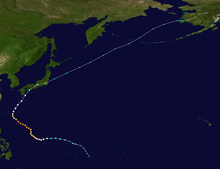Typhoon Tokage
| Typhoon ( JMA ) | |||
|---|---|---|---|
| Category 4 Typhoon ( SSHWS ) | |||
| Typhoon Tokage on October 19th | |||
| Emergence | October 13, 2004 | ||
| resolution | October 20, 2004 | ||
|
Peak wind speed |
|
||
| Lowest air pressure | 940 hPa ( mbar ) | ||
| dead | 95 | ||
| Property damage | Unknown | ||
|
Affected areas |
Japan | ||
| Season overview: 2004 Pacific typhoon season |
|||
Typhoon Tokage ( Japanese: ト カ ゲ , lizard ; JMA name : 0423 ; JTWC name : 27W ; PAGASA name : Siony ) was a typhoon that passed over Japan on October 20 and 21, 2004, leaving a trail of devastation. It was the strongest tropical cyclone in the northwestern Pacific Ocean since Typhoon Tip . It reached its lowest air pressure at 940 hPa.
This tropical cyclone was the 23rd typhoon in 2004 and hit the Japanese islands directly. The main island of Honshu with the prefecture of Kyoto was particularly affected . Tokage caused damage amounting to over five billion euros. 99 dead, 704 injured and three missing were on his account.
Development and course
Typhoon Tokage originated east of the Mariana Islands on October 12, 2004 and was classified as a tropical storm by the Joint Typhoon Warning Center . At that time it was reaching an average wind speed of 35 knots . Five days later, on October 17th, Tokage was already a Category 4 typhoon at 125 knots. Due to a change of course, triggered by the ocean current below , it weakened until the next day and on October 18, at 105 knots, it was only a Category 3 typhoon.
Tokage hit mainland Japan on October 20th. A day later, on October 21st, he left the islands to the northeast and disbanded on October 23rd.
Web links
- Train
- Typhoon Tokage off Taiwan
- By Tokage damage caused (English)
- Cabinet Office : Disaster Control Report Typhoon No. 23 (Japanese; PDF; 297 kB)

